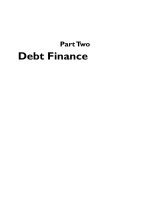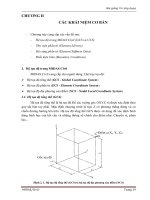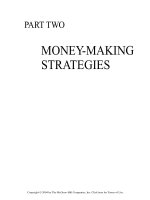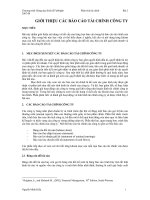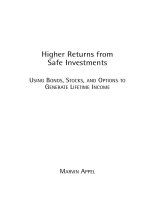101Option Trading Secrets Section 2 doc
Bạn đang xem bản rút gọn của tài liệu. Xem và tải ngay bản đầy đủ của tài liệu tại đây (602.84 KB, 38 trang )
Section 2
The
Prediction
GameSecret
6
THOSE WHO USE
CRYSTAL BALLS
EAT CHIPPED
GLASS
“It is not for us to forecast the future but to shape it.”
— Antoine de Saint-Exupery
Every one tries to beat the market by trying to predict the
future. The problem is that 90% of all investors are horrible fail-
ures at trying to predict short term moves in stocks, indexes and
futures. Even the professional shows a dismal record.
Study after study shows that 80% to 90% of the stock mu-
tual funds underperform the indexes and stock market averages
year after year. This means that investing in an Index Fund where
no management is involved is wiser than investing in a mutual
fund of stocks. There is no need to pay those management fees.
This also tells you that future stock price actions are unpre-
dictable. When the pros, who are paid hefty salaries, can’t beat
the averages, who can?`
In fact, the brokerage firms spend millions and millions of
dollars trying to find systems that will predict future stock and
commodity prices, and their results have not been good. Some of
our top scientists spent millions of dollars trying to develop a sys-
tem for predicting stock prices and were unsuccessful. (However,
they were able, after extensive research and testing, to develop a
system to predict index prices. Check out the book, The Predictors
by Thomas A. Bass.)
Hence, there are no crystal balls for predicting the markets.
Academic studies strongly suggest that the markets move ran-
domly ( Check out A Random Walk Down Wall Street by Burton
G. Malkiel, now in its 8th edition.) And, if the top brains and spe-
cialists, backed by millions of dollars, can’t beat or predict stock
movements, why should you be able to do so? Therefore, the best
way to approach the markets is to assume that they are random.
Many investors that I have encountered have a totally irra-
tional view of their ability to predict the market. On numerous oc-
casions, investors have asserted that they were 99% sure that the
market would move up or down, and most of the time they have
been wrong. In fact, some have become angry when I say that the
markets approach randomness.
The problem that all investors face is that the markets are
very efficient. That means that they have digested and discounted
THE PREDICTION GAME
20
all the information that is available and, thus, have discounted
present trends and potential future events.
Furthermore, in this information age of the internet, this
discounting occurs very rapidly. For example, the stock market
moves six months before events occur, such as a recession bot-
tom. Consequently, almost all future price moves are based on
surprise news and events not available to the public.
As for trend followers, trends can be changed radically by
chaos theory , which states that small unrelated events can have
a major impact on future events or trends. Therefore, it is best to
assume the markets are random, rather than try to predict and
bet on the unpredictable.
The big advantage to options is that you don’t need a crystal
ball. In fact, you don’t have to be right about the market 50% of
the time. Some option strategies win 90% of the time regardless
of what the market does. If you are an option buyer, one winner
can pay for many losses. As a result, you can be wrong about the
market most of the time and still be a winner.
In my Complete Option Report, when making recommenda-
tions over seventeen years, I assumed that the markets were ran-
dom. We always recommended three puts and three calls for
purchase in each issue. Even with this random approach, the op-
tions theoretical portfolio showed impressive returns over that
period.
So, throw out your crystal ball and trade options!
THOSE WHO USE CRYSTAL BALLS EAT CHIPPED GLASS
21
7
BEWARE OF
LADY LUCK
Most investors invest by the seat of their pants, and when
they are successful, they believe they can predict the markets. In
many cases, it is a matter of pure luck.
When you buy options, your odds of winning on any play are
lower than most people think. My Complete Option Report track
record in the 80’s showed two years with an overall percentage
return of over 1500%, but only 20% of the positions recom-
mended were profitable. Your probability of winning when you
buy options will always be less than 50% in a random market.
Furthermore, with out-of-the-money options, that percentage
can drop dramatically.
Here it is important to understand your odds of winning.
Millions of people buy lottery tickets, yet your chances of win-
ning the big prizes are so remote that you have the same chance
of winning whether you play or don’t play. State lotteries are
actually a voluntary tax system. Knowingly or not, people who
play are making a voluntary tax payment to their state.
In the casinos of Nevada, there is an ancient game of Keno
where twenty numbers are picked from one to eighty. Fifteen-
point Keno, where you try to pick fifteen out of twenty numbers,
pays $100,000 for a $1.00 ticket. What are your odds of winning?
Your true odds are over 430 billion to one. Of course, no one has
ever hit the fifteen-spot Keno, and they never will, but thousands
of gamblers keep trying.
Throughout the book, we will emphasize how to measure
your odds of winning when you trade options. However, even if
you know your odds of profiting, Lady Luck will try to trick you,
for in the world of probabilities, there are winning streaks and
losing streaks.
Here is an example: during the 2001 National Basketball
League (NBA) playoffs, the Sacramento Kings in one game
missed twenty-two 3 point shots at the basket in a row, and they
were one of the highest scoring teams in the league. Now a NBA
player should hit a 3 point shot about 35%–40% of the time, so
even if your odds of winning approaches 50%, you still can have
long losing streaks. Therefore, even if you are doing everything
right when you trade options, you could incur a long losing
streak.
Such streaks discourage the option trader. Many quit or
change their system or methodology and start making the wrong
moves, extending their losing streaks. We see this behavior fre-
quently with baseball players. When they go into a slump and
THE PREDICTION GAME
24
cannot get a hit, they change their style of hitting and slip into a
greater slump.
Lady Luck has a tendency to make us look very brilliant or
very stupid. Consequently, as you trade options, beware of Lady
Luck. If you are an option buyer, be prepared for losing streaks,
stick to your game plan and don’t get discouraged.
Of course, this is difficult to do and is a major obstacle for
the option buyer. If you can’t handle a lot of losses, then you
might want to consider option strategies with much higher prob-
abilities of profit, which we will disclose in future chapters.
To reiterate, as you trade, beware of Lady Luck and don’t let
her trick you into making the wrong move!
BEWARE OF LADY LUCK
25
8
REGRESSION
BACK TO
THE MEAN
“Regression back to the mean” is a statistical law that indi-
cates that when the results for some specific period or series of
events is extremely good or extremely bad, you can expect the re-
sults to move closer to normal or the long term average.
For example, if a baseball team is really hot and wins a lot of
games in a row, it is likely to win fewer games in the future. In
pro football, the super bowl champion is likely to show poorer
performances in the next year, especially at the beginning of the
season, as it regresses back to the mean.
The same applies to the stock market. A hot fund manager is
likely to cool off next year. A wild bull market is likely to end up
in a bear market or major correction. When the stock market is
very quiet, it is likely to get much more volatility—the calm be-
fore the storm. Options that are cheap and undervalued are likely
to become properly valued or expensive, and overvalued options
tend to get less expensive.
The regression back to the mean phenomenon is quite obvi-
ous when investors pick mutual funds or investment advisors.
Generally, investors have very short vision. They only look at
present performance when much of that performance could be
luck rather than skill. Here you are likely to see regression back
to the mean. Today’s hot mutual funds are likely to underperform
in the future.
The law also applies to your behavior. If you are on a hot
streak, look out! You’re due for a losing streak as you regress to
the mean.
“Regression back to the mean” is one of the few tools that
you can use to forecast the future.
THE PREDICTION GAME
28
9
BEWARE OF
GURUS
Many option investors are always in search of a free ride.
They are looking for the guru that will lead them to the promised
land or the system that is the Holy Grail. There is no system that
will work all the time, and although there are analysts who are
very good, they, too, will have their cold streaks.
One well known advisor once predicted market moves
eleven times in a row and then suddenly and over a three year pe-
riod missed several major moves in the market. This is an exam-
ple of why picking a truly good advisor can be quite difficult.
Good performance is usually the result of Lady Luck, and if the
markets are unpredictable, a guru in the long run will not pro-
vide much help.
Nor is there any surefire system. A system may work for a
while and then suddenly stop working.
Being successful in the options market depends on you! Too
many investors seek out a guru who will make all their decisions;
they will not take responsibility for their own actions. The only
way to “make it” in the option markets is to earn it. Use the wis-
dom of the experts, but make your own decisions and be willing
to take the responsibility for those decisions. No one will lead you
to the promised land except you!
THE PREDICTION GAME
32
Secret
10
SECRET
PREDICTION
METHODS
In Secret #6. we discussed the almost impossible task of pre-
dicting futures and stock prices. However, out there are some
methods that will improve your ability to predict the future; in
other words, crystal balls that work sometimes. We live in a prob-
lematic world where there are no sure things, but there are ways
to bend the odds in your favor where you are right about the fu-
ture more often than you are wrong.
We are in the midst of a technological revolution. In the
next two decades computers will probably become more intelli-
gent than humans. This is due to the fact that microprocessors’
speed doubles every eighteen months and has for the past thirty
years. The explosion in technological development will accelerate
as the computer becomes more intelligent.
Forecasting techniques that have developed due to this rev-
olution include neural nets and genetic algorithms. These tech-
niques are only possible with high-powered computers, which
are now even in the home.
Neural nets use a methodology similar to how our brains
work and identify patterns in data that cannot be identified by the
naked eye.
Genetic algorithms is an evolutionary process similar to
how we evolved from microorganisms over millions of years.
With super fast and powerful computers, the evolutionary
process can be replicated on the computer.
One company, Ward Systems, has trading systems software
that use neural nets and have developed a specific software that
may give you an edge. We also have experimented with neural
nets in predicting stock index moves and have formed systems
that predict market moves about 60% of the time. Nevertheless,
because even neural nets can only have a small porthole on the
future, this still tells us that the markets approach randomness.
Besides, these artificial intelligence tools, such as neural
nets, do require a lot of work and a lot of continued retraining to
implement.
Furthermore, even with these futuristic techniques for pre-
dicting the markets, when too many people use these methods
and millions of dollars are poured into this process, the markets
will become even more efficient and the future less predictable.
You may be able to develop a system that finds a peep hole
on the future, but that could take a lot of work and continued re-
tuning of your system.
Here, again, the advantage of options trading comes
through; you don’t have to predict the future.
THE PREDICTION GAME
34
Secret
11
MAVERICK
INVESTING
To truly predict what the markets will do in the future, you
need to look at the field of psychology and group behavior.
Since the start of the NYSE, it is well known that specialists
who make a market in listed stocks make a lot of money each
year. Why? Because they are forced to buy stock when prices are
falling and sell stocks when prices are rising. Their job is to make
a market in a stock, which means they must buy stock when
everyone wants to sell and sell stock when everyone wants to buy.
This forces them to be on the other side of the crowd. Emotion-
ally they prefer not to be in that position. In fact, when the mar-
ket is falling, they would prefer to be also sellers. The specialists
in a sense have been forced to be contrary investors in the very
short term. Consequently, in the end they are the winners.
Markets at times tend to move to extremes. When they do,
you have a chance to stack the odds in your favor and improve
your odds of predicting future price moves. The problem is that
when markets move to extremes, you, like everyone else, emo-
tionally don’t want to take an opposing position. Despite this
aversion, ironically, the best time to buy stocks is when there is
blood in the streets and when in the pit of your stomach, you feel
the world is about to end.
Markets tend to overshoot and undershoot their true value
and at times become irrational as we saw in the internet crash in
2000. Here it is easy to predict the future, if you have the guts to
go against the psychology of the crowd.
However, to be a successful contrary investor or maverick
investor, you must be patient and wait for the real extremes. Buy
when there is a lot of fear in the market and sell when there is a
lot of euphoria and greed in the market. You also must control
your greed in the midst of a bull market and control your fear at
the bottom of the market.
One indication of whether the stock market is near a bottom
is the CBOE Market Volatility Index (VIX). This index measures
the implied volatility of the S&P 100 Index Options and, as a re-
sult, is a good measure of the fear in the market.
When implied volatility is high, options are expensive. This
is because when there is a lot of fear in the market, investors buy
put options, forcing put prices up, making options more expen-
sive, and the VIX measures how expensive options are. The
higher the VIX, the more fear there is in the market.
The index moving above 35% suggests that we are near a
market bottom. (There is one exception to this rule. If the market
THE PREDICTION GAME
36
is really volatile, the VIX should be high to reflect that volatility.
Then the VIX will not be as predictive.)
Knowing how fear and euphoria work in the market and
using it for you rather than against you is a self-discipline you
have to acquire. Emotionally as well as intellectually, you have to
prepare yourself for the game.
MAVERICK INVESTING
37
12
TRACKS IN
THE CHARTS
Even though the markets approach randomness, technical
charts of stocks or futures can provide some clues or tracks to
what will happen in the future. However, readings from the
charts are never a sure thing and should always be taken with a
grain of salt.
Many traders take factual data too seriously, and many get
lost in the trees. A chart of a stock’s price action including its
trading volume should be treated as signs in the sand of what the
future might hold. Charts are pictures of supply and demand.
They show you the trend and where the price will find support
and resistance.
I look closely at support and resistance when designing my
strategies, especially when setting stop-losses and profit goals. I
also watch for breakouts from tight trading ranges. This supports
a major change in volatility and improved odds of a major move.
Nevertheless, this again is not a sure thing. I put much
more importance on trends when there is a lot of volume and no
news to support the move.
Charts are not crystal balls but can provide signs to what
may happen in the future, especially when they are not supported
by news items and they are seen as a picture of supply and de-
mand. They tell you where the money is flowing. For example, a
stock price falling below long term support, or a place where it
has found a lot of support in the past, suggests that a lot of
money is flowing out of the stock and the stock price is likely to
continue falling.
When a stock or futures makes a new high, it is likely to
move higher for the resistance is rare at the level of a new high.
There is no one left who is desperate to sell at a new high; i.e. no
one still hanging on who was left holding the bag on the last
major run up in the stock or futures.
However, there are buyers in line waiting to jump on the
band wagon on any pull back. Likewise, when a stock or futures
is making a new low, it is likely to move lower, for on any rally,
sellers who were left holding the bag are waiting in line to get
out.
Action in the charts becomes more valuable when there is
no news to support the price action. Because the charts can tell
you something is happening behind the scenes that the public is
not aware of, they become crystal balls. This is where the slogan,
“Buy on the rumor and sell on the news, “ comes into play.
How good are charts at predicting the future? Well, they
sure beat fundamentals. The charts were giving “sell” signals on
THE PREDICTION GAME
40
stocks such as Enron, WorldCom and Adelphia Communications
long before their demise. Fundamentals told you to sell when
these stocks were almost worthless. In fact, when large brokerage
firms give sell signals on stocks, most of the damage to the stock
price has already been done. The answers are in the charts, not in
the fundamentals.
Option prices can also foretell the future. When option pre-
miums on a stock are suddenly very expensive and overpriced
even though the stock price is not moving much, you should be
suspicious. It suggests a news event or development that has not
been exposed to the public.
In conclusion, the charts can foretell the future if you are a
good detective and don’t get lost in every tick of the tape. Despite
this, remember, there are no sure things in the charts, just hints
about what the future holds.
TRACKS IN THE CHARTS
41

